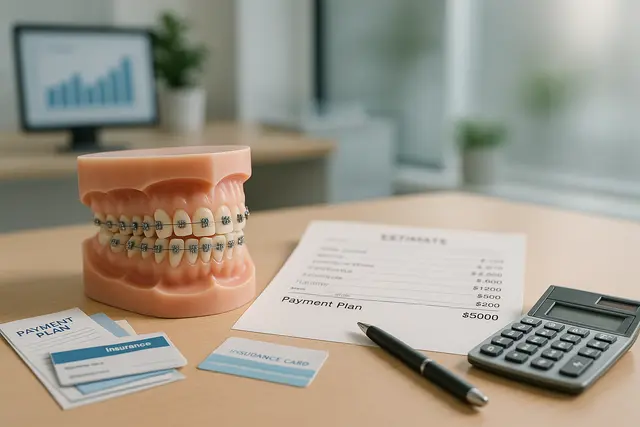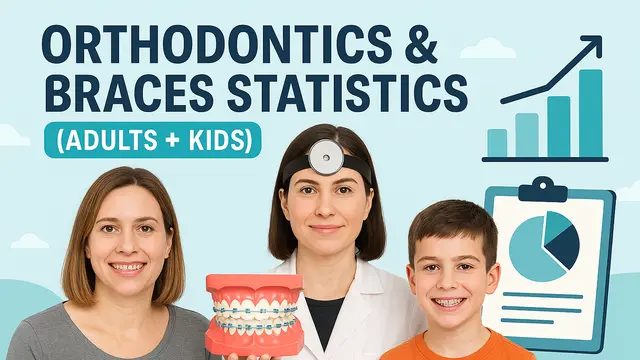Orthodontics
5 min read
Apr 03, 2025
Braces Financing: Understanding Payment Plans, Insurance, and Flexible Spending Accounts
Orthodontic treatment isn’t just about aesthetics; properly aligned teeth can reduce the risk of gum disease, jaw strain, and uneven wear. But braces typically cost thousands of dollars, creating a financial burden for many families. While the price can be a barrier, it doesn’t have to be a dead end. Financing options like payment plans, insurance coverage, and pre-tax savings accounts allow patients to move forward with treatment in a way that fits their budget.

Brace Financing Basics
If you’re considering braces, the first number that pops into your head is usually the price tag. Braces can vary widely, but the average cost of braces in the United States hovers between $4,500 and $7,000, according to the American Dental Association.
That sticker shock often sends families hunting for a way to pay that feels less like a root canal on their wallet. Good news: flexible financing options are available, and they can turn a jaw‑dropping lump sum into manageable monthly payments.
Why Orthodontic Treatment Costs What It Does
Orthodontic treatments like traditional metal braces, clear aligners, ceramic braces, and lingual braces all require precision hardware plus an orthodontist’s expertise. Each brace bracket is custom‑placed, and that craftsmanship, paired with multiple office visits, drives treatment cost.
Materials matter, too; ceramic braces function similarly to metal braces but use tooth‑colored or clear brackets that bump the cost of ceramic braces higher than the cost of metal. Add diagnostics, custom retainers, and follow‑ups, and the overall cost can climb fast.
Financing Options for Braces
Orthodontists offer a surprising variety of financing plans, often in‑house. These interest‑free payment plans allow you to pay in predictable chunks and spread the cost of treatment over 12 to 36 months. Monthly payment options differ, so ask about minimum upfront payment, financing terms, and late‑fee policies before you sign.
If your budget needs even more wiggle room, third‑party healthcare credit card providers can extend longer repayment windows, but watch for interest once any promotional period ends. The key is to pick a plan that lets you manage the costs without turning your confident smile into financial stress.
Dental Insurance and Insurance Coverage
Many dental insurance plans treat braces as an elective upgrade, yet dental insurance may still chip in $1,000 – $2,500 once per lifetime. Read the fine print: some policies cover braces without age caps, while others limit orthodontic coverage to children.
Verify whether your insurance provider reimburses the orthodontist directly or sends checks to you; that affects out‑of‑pocket costs and cash‑flow timing. If you don’t have dental insurance, ask your employer’s HR department about group insurance options or shop the marketplace. Even partial insurance benefits can reduce the overall cost and make the treatment more affordable.
Flexible Spending and Health Savings Accounts
Employees with a Flexible Spending Account can funnel pre‑tax dollars, up to $3,200 in 2025, toward orthodontic care. A Health Savings Account works similarly but sticks around year after year, perfect for parents mapping out a multikid orthodontic timeline. Either option is a tax‑smart way to pay for braces treatment because every dollar diverted lowers taxable income. Just remember FSA “use it or lose it” rules and schedule your treatment plan accordingly.
Healthcare Credit Cards and “Expensive Dental Procedures”
If you’ve maxed out workplace benefits, a healthcare credit card can be the way to pay for braces quickly. These cards often feature six‑, 12‑, or 18‑month interest‑free windows on expensive dental procedures, including orthodontic treatments. Make sure you can wipe the balance before interest kicks in; rates after the promotion can turn flexible financing into a budget crusher.
Metal Braces, Clear Aligners, and Other Options for Braces
Traditional braces are often the most cost‑effective, but appearance of braces matters to many teens and adults. Clear aligners cost slightly more, yet the nearly invisible trays let you straighten teeth on the sly. Lingual braces hide behind the teeth, while ceramic offers a middle ground: brackets that blend with enamel.
Because braces ranges in price can get confusing, ask your orthodontist for a side‑by‑side chart that lists cost of metal, cost of ceramic, and treatment length. It helps you make informed decisions based on both appearance and wallet.
Payment Options for Braces If You Lack Insurance
Don’t panic if you’re contemplating orthodontic care without coverage. In‑house payment plans, interest‑free financing, and healthcare credit lines all exist because braces are often a once‑in‑a‑lifetime purchase.
Some practices even discount upfront payment by five to ten percent or let you combine an upfront chunk with lower monthly payment to reduce financing fees. That hybrid approach can slash out‑of‑pocket costs while keeping cash flow comfortable.
Managing the Fine Print
Before you sign anything, review financing terms, late‑fee triggers, and what happens if you move mid‑treatment. Ask how much you can expect to pay for emergency visits and replacement retainers, too. These smaller charges may not seem big today, yet they add to cost of treatment over two or three years.
Tips to Navigate the Financial Aspects Like a Pro
Start with a comprehensive consult. The American Association of Orthodontists recommends seeing a specialist by age seven, but adults are welcome any time. Early chats help you map braces financing years in advance.
Compare insurance and financing head‑to‑head. One family might save more with robust insurance cover; another might win with flexible financing plus an FSA boost. Run the numbers.
Budget beyond brackets. Retainers, checkups, and the occasional broken bracket can nibble at your wallet. Build a small “oral health” cushion so surprises don’t sabotage your plan.
Keep paperwork tidy. Insurance policies and payment plan agreements are dull reading, but they spell out exactly what’s covered and what isn’t. A quick phone snapshot stored in the cloud makes claims simpler.
Revisit financing options each year. If income rises or tax law changes, a fresh health savings account or updated insurance options could reduce what you still owe.
What You’ll Likely Pay
People always ask, “How much do braces cost?” No two mouths, or budgets, are identical, but you can expect to pay for braces somewhere in that $4,500 – $7,000 zone for traditional braces and up to $9,000 for niche solutions. Insurance and financing together can chop that down into affordable, bite‑sized pieces.
A Quick Word on Upfront Payment
If you happen to have cash on hand, an upfront payment might snag the biggest discount of all. Practices love simple bookkeeping, so they often reward pay‑in‑full courage with a price break.
Final Thoughts on Finding Your Best Way to Pay
Braces without financial headaches are possible when you line up every resource, insurance options, in‑house payment plans, flexible spending, health savings, and even a healthcare credit card.
Crunch the math, ask questions, and lean on your orthodontist’s staff to help you navigate the financial maze. Once the plan is set, you can focus on the fun part: imagining the day you flash a straight, confident smile in every photo.
How Much Do Braces Typically Cost?
Braces usually cost between $4,500 and $7,000 in the U.S., depending on the type of braces, treatment complexity, and duration. More discreet options like ceramic or lingual braces may cost more. Clear aligners can also be pricier but offer more flexibility and invisibility.
What Financing Options Are Available for Braces?
Many orthodontists offer in-house, interest-free payment plans that let you pay monthly over 12 to 36 months. You can also use healthcare credit cards, which may offer promotional interest-free periods. Always review the terms and fees before committing to any financing agreement.
Can Dental Insurance Help Cover Braces?
Yes, but coverage varies. Some plans contribute $1,000–$2,500 once per lifetime, often with age or treatment limitations. Check if your plan reimburses you or pays the provider directly, and confirm whether adult orthodontics is included.
Are There Tax-Advantaged Ways to Pay for Braces?
Absolutely. Flexible Spending Accounts (FSAs) and Health Savings Accounts (HSAs) let you use pre-tax dollars to cover orthodontic care. FSAs have annual limits and expiration rules, while HSAs roll over yearly, making them great for long-term planning.
Read Next
Related Posts

Orthodontics
Retainer That Looks like Braces: Benefits for Long-Term Alignment
A retainer might not get as much attention as braces, but it plays a crucial role in maintaining your smile after orthodontic treatment. Whether you're new to retainers or curious about the type that looks like braces, understanding their purpose and benefits is key to keeping your teeth aligned for the long haul.
6 min read
Sep 15, 2025

Orthodontics
How Much Are Metal Braces? Cost Comparison With Other Options
Thinking about getting braces but overwhelmed by the cost? You’re not alone. Orthodontic treatment can be a major investment, and understanding the different price points, from metal braces to clear aligners, can help you make a smart, confident decision.
5 min read
Sep 15, 2025

Orthodontics
Orthodontics & Braces Statistics (Adults + Kids)
Orthodontics has transformed from a niche medical service for teenagers into a booming sector that spans all ages. Today, both adults and children seek orthodontic treatment to improve their smiles, fix bite issues, and boost self-confidence.
4 min read
Aug 21, 2025
Don’t have time to research every dentist around you?
See why 30k+ patients trusted us